
A visit to St Faith’s Church, home of the Bacton Altar Cloth
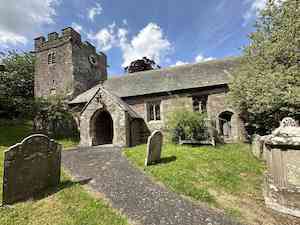
St Faith's Church Bacton, Herefordshire
The charming little church of St. Faith’s, Bacton, stands high above a valley carved out by a meandering river. The Dore flows from the foothills of the Black Mountains to merge with the River Monnow, which then joins the majestic River Wye.
The name Dore may derive from a Welsh word, ‘dwr’ which means water. But the Normans interpreted it as the French word ‘d’or’ meaning golden, and it became known as “The Golden Valley.” Bacton, in modern-day Herefordshire, only five miles (8km) from the Welsh border, is one of the most remote and the most beautiful places in the Welsh Marches.
On a sunny day in July, we follow the winding lane to Bacton. I have been yearning to visit the church here for quite some time, because St Faith’s church was, for centuries, the home of a remarkable piece of fabric. It’s a very special moment for me as, at last, I stand at the church gate.
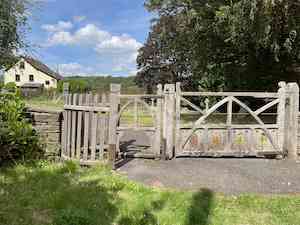
The church gate at Bacton - photo my own
I notice an ancient yew tree. This must have been a sacred place long before they built the current church, with its squat tower. The church dates back to the 13th century, but the site surely has a much longer history.
As I begin my walk up the path, I pass by the somewhat unusual gravestones without paying much attention. My excitement grows with each step.
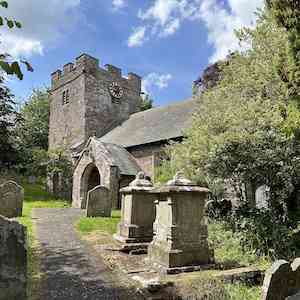
Bacton church — photo my own
I don’t stop to read the names listed on a board in the porch wall, but grasp the ring and give the door a mighty shove. It creaks open and I hover on the threshold, waiting for my eyes to adjust to the sudden darkness inside. And then, I spot it — hanging on the wall across from the door is the very thing I came here to see. I know it is a replica, positioned where the original cloth had hung for over a century. Yet I’m still overwhelmed to see it. Some might find it strange that I am captivated by this imitation, considering I had seen the real one displayed at Hampton Court Palace in 2019. But for me, it is the fact that it is here, in its rightful place, that matters.
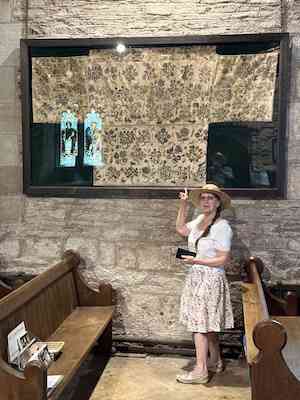
Here I am in St Faith's church — photo my own
For a long time, the people of Bacton suspected the significance of the embroidered cloth gifted to the church by a local girl, Blanche Parry. Some believed that their altar cloth had a close association with Queen Elizabeth I. A hundred years ago, Charles Brothers, the rector, was so sure of this that he arranged for the cloth to be framed and displayed on the church wall.
There it stayed until 2016 when Historic Royal Palaces curator, Eleri Lynn, studied it. By looking at the seams, Eleri could confirm it had once formed part of a skirt. She could date it to the late sixteenth century. On careful examination, she discovered it was made of cloth-of-silver, a fabric woven with a silk thread with a thin strip of beaten silver wound round it. Strict Sumptuary Laws restricted cloth-of-silver fabric to the highest in the land — only a Countess or member of the Royal Family could wear it. So this was an important clue to the original owner of the altar cloth.
The level of craftsmanship in the flowers and herbs suggests they are the work of professional embroiderers. However, it appears that a less skilled hand added the animals, butterflies, and other beasts at a later date.
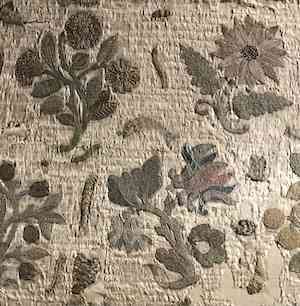
Close up taken at the 2019 exhibition at Hampton Court Palace — photo my own.
The fabric and the quality of the exquisite embroidery shows that the Bacton Altar cloth must have belonged to someone of high status, almost certainly the queen herself. It has a remarkable resemblance to that worn by Queen Elizabeth in the iconic Rainbow Portrait.
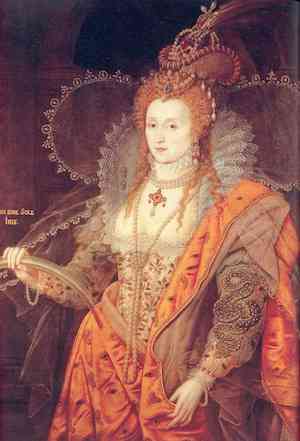
The Rainbow Portrait - In the collection of the Marquess of Salisbury on display at Hatfield House - sourced via Wikimedia Commons
The Bacton Altar Cloth and me
When I visited the exhibition at Hampton Court Palace in 2019 and saw the original embroidered cloth, it entranced me so much that I decided to return for a second time.
Photos taken at the exhibition at Hampton Court Palace December 2019
I’ve had an even closer look online. During the COVID pandemic, I joined Zoom meetings arranged by the Medieval Dress and Textile Society (MEDATS) when a team of Tudor costume, textile, and art scholars studied photos of the cloth to identify the plant species represented. You can find out more here https://bacstitch.org/what-we-see/
This research fascinated me because of my interest in embroidery, sixteenth-century clothing, and the lives of women during that time. That is why seeing the place where people have cherished the Bacton Altar Cloth for so long meant so much to me. My fascination with the Altar cloth continues. I’ve even completed an embroidery piece inspired by one of the flowers represented on it — a thistle.
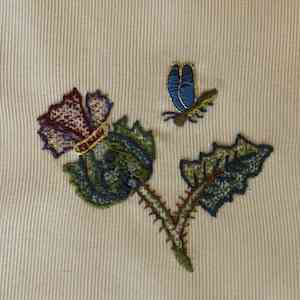
Embroidered thistle from a Royal School of Needlework design inspired by the Bacton Altar Cloth.
Who was Blanche Parry?
Blanche Parry was born at nearby Newcourt around 1508. She was the daughter of Henry Parry and his wife Alice (Milbourne).
At the Tudor Court, family connections mattered. Blanche was related to the influential Stradling family, and she was Lady Troy’s niece. Lady Herbert of Troy, to give her full title, was the “Lady Mistress” of King Henry VIII’s infant daughter, Elizabeth.
Blanche’s name appears on a list of gentlewomen appointed in 1536 to serve three-year-old Elizabeth. Blanche herself asserts (see below) she saw Elizabeth ‘ rocked in her cradle.’ So she may already have had a place in the Royal nursery before Anne Boleyn’s downfall.
In 1565, when Katherine Ashley died, Blanche took over as First Lady of the Privy Chamber. She held that very influential position for 25 years, until her death. Blanche was with Elizabeth all the time — from early childhood until the Queen was 56 years old. And historical records show that Elizabeth often gifted her discarded clothing to Blanche.
I’m researching Katherine Champernowne, who became Elizabeth’s governess and later married John Ashely. She served alongside Blanche for nearly 30 years. By discovering more about Blanche, I hope I may come to understand Mrs Ashley a little better.
Blanche Parry’s memorial
At Bacton Church, in my quest to find another connection to Blanche, I wander towards the altar. Her memorial is on the north side of the sanctuary.
When Blanche became ill in the late 1570s, she planned to retire to the family estate of Newcourt. In 1578 William Cecil, Lord Burghley, supervised Blanche’s will. Cecil was a relative and also a friend she had worked with for many years. She also commissioned the installation of this monument in her local church before November 1578.
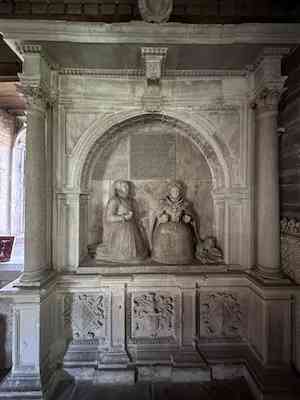
Monument to Blanche Parry, St Faith’s Church, Bacton — photo my own
However, she must have recovered for she did not retire. Although her eyesight was failing so much that she was virtually blind, Blanche continued to serve at the Royal court. William Cecil was again supervisor for Blanche’s last will before she died in February 1590, (shown as 1589 under the old calendar). The queen paid for a funeral at St Margaret’s Church Westminster, which gave Blanche the status of a baroness. The tomb in Bacton Church is therefore empty,
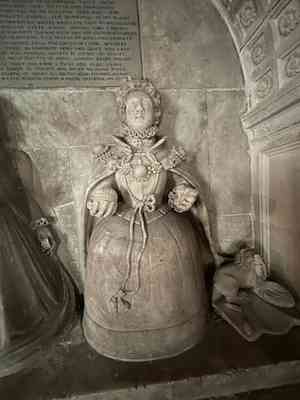
Monument showing Queen Elizabeth as ‘Gloriana’ —photo my own
The figure of Elizabeth in Bacton Church is the earliest known depiction of the queen as Gloriana — the Virgin Queen.
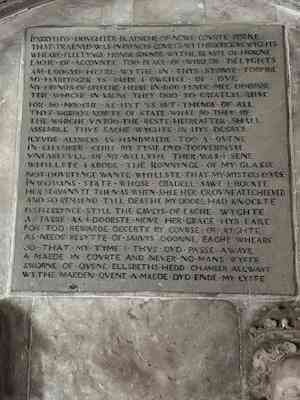
Inscription. monument to Blanche Parry, St Faith’s Church, Bacton — photo my own
Blanche may have composed the twenty-eight line inscription herself. Roughly translated, it ends as follows;
Time I did thus pass away
A maid in court and never no mans wife
Sworn to serve in Elizabeth’s chamber
Always with the maiden queen
A maid did end my life.
Some have taken this as proof that Elizabeth remained a virgin to the end of her life.
Conclusion
Moved by the monument and the story of Blanche Parry, the faithful servant of Queen Elizabeth, who never married, I returned to study the replica cloth again. How wonderful that the Bacton Altar Cloth has survived to put us in touch with this woman and the queen she served. But it also connects us to the people who worked their magic in thread all those years ago on a length of cloth-of-silver.
As I leave, pulling the door quietly shut behind me, I notice Blanche’s bequest to the local people listed on the Bequest Board on the porch wall. Later, I discover that they still pay £14 each year to the parishioners of Newton (now Newton Saint Margaret’s) and £14 to the parishioners of Bacton. But surely the rare and beautiful cloth she donated to the church has been her greatest legacy.
